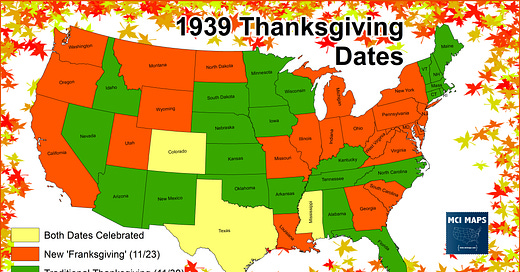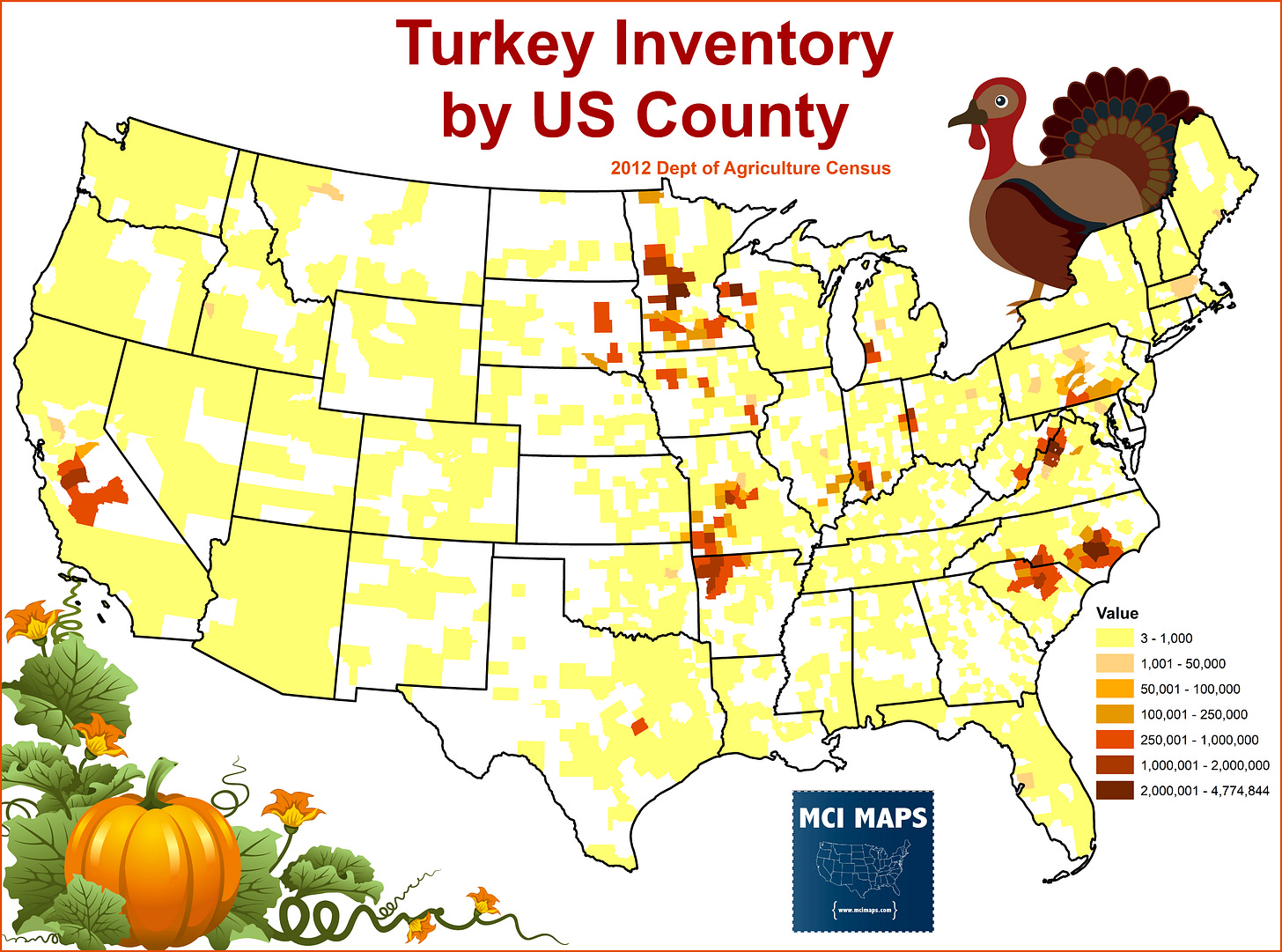Special Issue: Thanksgiving in a Divided America: The Story of "Franksgiving"
Imagine this debate today
Note: This is a repost/edit of a 2023 article - longtime followers will know I’ve talked about this historic story alot.
Well, here we are, another Thanksgiving after a contentious election. For millions of Americans, this will be the first time seeing extended family after the votes on November 5th were counted. Many families are divided; fractured along lines of people who care about morality and democracy, and people who think the President magically controls egg prices.
But while there may be some divide within your family this season, it is nothing compared to the divide back in the 1930s and 1940s. Imagine a political divide so deep that it led to Thanksgiving being on different weeks depending on the state you lived in? Well, if you haven’t heard of this story before, I present to you the classic story of “Franksgiving.”
The Story of “Franksgiving”
Today, we all know Thanksgiving for being held on the 4th Thursday of November. However, this was not always the case. Thanksgiving had, up until the 1930s, been the last Thursday of November. While this often was the 4th Thursday, there are plenty of years where Thursday manages to sneak in a 5th Thursday. At times, this would put Thanksgiving closer to Christmas than normal, but for a long time, this was considered no big deal. Thanksgiving was proclaimed every year by the President, with less formality built in via state or federal laws.
Then in 1939, as the country continued to wade its way through the Great Depression, the Thanksgiving date was set to fall on November 30th; the 5th Thursday of the month. Business owners worried that the short time between Thanksgiving and Christmas would lead to fewer present purchases; and hence fewer for companies that were relying on a holiday rush. This was still a few years before “Black Friday” would become a coined phrase - but this was the era where the post-Thanksgiving period was known for more Christmas shopping.
Taking this issue to heart, President Franklin Delano Roosevelt decided to declare November 23rd Thanksgiving; the 4th Thursday. This would give an extra week before Christmas, and hopefully yield more purchases.
Well, all hell broke lose. Multiple states declared they would not move the date. Some reasons were partisan, others were more local. Namely, many states had their big college football rivalry games scheduled for what they presumed would be the traditional Thanksgiving date. This included southern Democratic states. Opponents of the earlier date derided the the November 23rd as “Franksgiving” - after the President’s first name.
A large number of states refused to go along with “Franksgiving” - and insisted on holding their state holiday on the traditional last Thursday. In the end, the nation became a patchwork of different dates for the holiday. Three states opted to celebrate both days.
How these date decisions match with partisan control of the Governors, who were the ones to ultimately decide what might be a paid state holiday, show little correlation at first.
Some GOP governors opted to go with FDR on the new date, while others rejected the push as federal overreach. Many Southern Democrats, who never had the easiest relationship with FDR, also had no issue bucking him - especially if the football matches were already set. In deep-blue Arkansas, a football coach went on record saying
We'll vote the Republican ticket if he (FDR) interferes with our football
Arkansas would remain a firm “traditional” Thanksgiving state through the next several years.
A Multi-Year Debate
One might think 1939 was the lone time this happened. Well just a year later, the same issue arose again. The 1940 November calendar had 5 Thursdays again. If Thanksgiving was to be the last Thursday of the month, it would fall on the 28th - leading to another short shopping season. The late holiday led to another FDR declaration for the week earlier, and another batch of states either deciding to go along with it or not.
By this point, Roosevelt was coming off his 1940 Electoral College landslide for a third term. Whether that factored into decisions or not - there were notably fewer states rejecting the FDR proposal. Partisanship was never a perfect driver of the issue. See below how these states decided to celebrate Thanksgiving compared with their vote for President in 1940. The Willkie states split on the date, but FDR states were much more in favor.
The story repeated itself again in 1941, with FDR aiming for a November 20th date instead of November 27th. Many states balking at an earlier Thanksgiving, while others going along with the President.
Here is where we can see how Governor control could sometimes change the Thanksgiving dates. Five states saw partisan control change their Thanksgiving dates.
Other states saw changes in dates but no changes in partisanship. Others changed partisanship but not in dates.
By this point the situation was untenable. Congressmen from the midwestern Turkey-producing states said that a uniform date was needed. Fun fact, here is where current Turkey inventory are in more modern times.
Turkey supplies were hardly the only issue. The issue caused problems for families in different states. In addition, some kids in counties on state borders might go to school across state lines. When the two states in question would have different Thanksgiving dates, it created issues for kids being out of school or not. This became issues for some eastern Iowa and western Illinois where border counties shared school districts.
The Attempted Compromise
By this point the data also showed that moving the dates earlier did not increase money spent on holiday shopping. With FDR’s blessing, Congressed passed a resolution in October of 1941 that said the 4th Thursday of every November would be Thanksgiving. Most years this was the last Thursday; per tradition. But in cases of a 5th Thursday, Thanksgiving would remain on the 4th week. This offered a balance that easily passed; and while it backed up the President, it also showed congress asserting its power. This remains the governing law to this day.
The resolution was first tested in 1944, which had a 5th Thursday in November. Most states stuck with the agreed date, aka the 4th Thursday, but a handful of states remained celebrating the end of the month instead. Most of the reasons cited were simple - tradition and/or football.
However, when the same issue came up in 1945, only two states - Tennessee and Arkansas - stuck with the “traditional date.”
There were a handful of conflicting dates in years to come, but by the 1950s everyone was on the same page. The last state to offer a different date from the resolution was none other than Texas. Read my original article for more details.
You can see the full 1939-1941 data set below! This represents the time of greatest controversy.
That’s all for this week.
Happy Thanksgiving!
PS: Pumpkin pie is the best pie.















